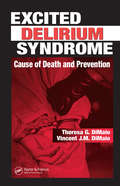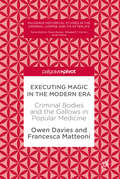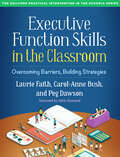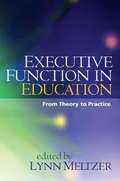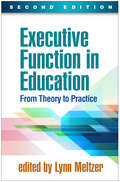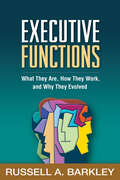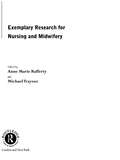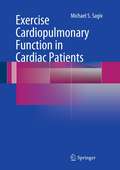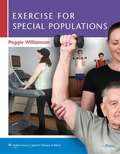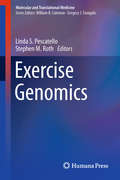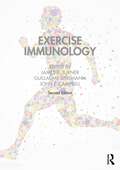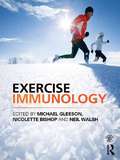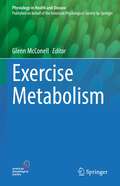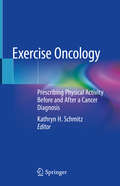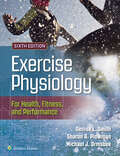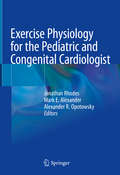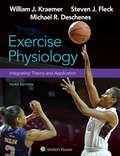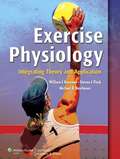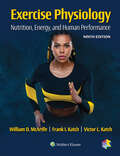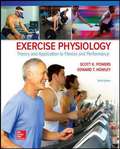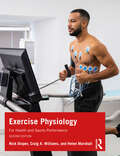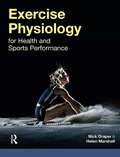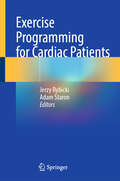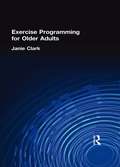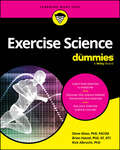- Table View
- List View
Excited Delirium Syndrome: Cause of Death and Prevention
by Theresa G. DiMaio Vincent J.M. DiMaio M.D.During a routine investigation, a suspect turns hostile. The officers on the scene spring into action and get the suspect� under control by handcuffing him. Though the suspect has been successfully subdued � he dies shortly thereafter� A psychiatric patient suddenly becomes violent. The hospital staff struggles to control the patient
Executing Magic in the Modern Era
by Owen Davies Francesca MatteoniThis book is open access under a CC BY 4. 0 license This book explores the magical and medical history of executions from the eighteenth to the early twentieth century by looking at the afterlife potency of criminal corpses, the healing activities of the executioner, and the magic of the gallows site. The use of corpses in medicine and magic has been recorded back into antiquity. The lacerated bodies of Roman gladiators were used as a source of curative blood, for instance. In early modern Europe, a great trade opened up in ancient Egyptian mummies and the fat of executed criminals, plundered as medicinal cure-alls. However, this is the first book to consider the demand for the blood of the executed, the desire for human fat, the resort to the hanged man's hand, and the trade in hanging rope in the modern era. It ends by look at the spiritual afterlife of dead criminals.
Executive Function Skills in the Classroom: Overcoming Barriers, Building Strategies (The Guilford Practical Intervention in the Schools Series)
by Peg Dawson Laurie Faith Carol-Anne BushWith insight and humor, this motivating guide shows how to bring executive functions (EF) to the forefront in K–8 classrooms--without adopting a new curriculum or scripted program. Ideal for professional development, the book includes flexible, practical, research-based ideas for implementation in a variety of classroom contexts. It shares stories from dozens of expert teachers who are integrating explicit EF support across the school day. Provided is a clear approach for talking about EF barriers and strategies as part of instruction, and working as a class to problem-solve, explore, and apply the strategies that feel right for each student. Purchasers get access to a Web page where they can download and print several reproducible tools in a convenient 8 1/2" x 11" size. This book is in The Guilford Practical Intervention in the Schools Series, edited by Sandra M. Chafouleas.
Executive Function in Education
by Lynn MeltzerThis uniquely integrative book brings together research on executive function processes from leaders in education, neuroscience, and psychology. It focuses on how to apply current knowledge to assessment and instruction with diverse learners, including typically developing children and those with learning difficulties and developmental disabilities. The role of executive function processes in learning is examined and methods for identifying executive function difficulties are reviewed. Chapters describe scientifically grounded models for promoting these key cognitive capacities at the level of the individual child, the classroom, and the entire school. Implications for teaching particular content areas reading, writing, and math are also discussed.
Executive Function in Education, Second Edition: From Theory to Practice
by Lynn MeltzerThis groundbreaking volume, now revised and updated, has given thousands of educators and clinicians a deeper understanding of executive function (EF) processes in typically developing children and those with learning difficulties and developmental disabilities. The book elucidates how PreK–12 students develop such key capacities as goal setting, organization, cognitive flexibility, working memory, and self-monitoring. Leading experts in education, neuroscience, and psychology explore the links between EF and academic performance and present practical applications for assessment and instruction. Exemplary practices for supporting students with EF difficulties in particular content areas--reading, writing, and math--are reviewed. New to This Edition *Expanded coverage of reading--chapters on recent fMRI research findings; working memory and reading; and self-regulation and reading comprehension. *Chapter on early childhood. *Chapter on embedding EF strategies in the curriculum *Updated throughout with a decade's worth of significant advances in research, theory, and educational best practices. See also Meltzer's authored book Promoting Executive Function in the Classroom, which provides easy-to-implement assessment tools, teaching techniques and activities, and planning aids.
Executive Functions: What They Are, How They Work, and Why They Evolved
by Russell A. BarkleyThis groundbreaking book offers a comprehensive theory of executive functioning (EF) with important clinical implications. Synthesizing cutting-edge neuropsychological and evolutionary research, Russell A. Barkley presents a model of EF that is rooted in meaningful activities of daily life. He describes how abilities such as emotion regulation, self-motivation, planning, and working memory enable people to pursue both personal and collective goals that are critical to survival. Key stages of EF development are identified and the far-reaching individual and social costs of EF deficits detailed. Barkley explains specific ways that his model may support much-needed advances in assessment and treatment.
Exemplary Research For Nursing And Midwifery
by Anne Marie Rafferty Michael TraynorThis Reader reproduces fifteen classic and influential accounts of nursing research selected by a panel of senior nurse researchers and teachers. It provides accompanying commentary explaining why the research is good, how it relates to the research tradition and the influence and impact of the piece of research.Introductory and concluding chapters review the literature on the evaluation of research and the position of nursing research in relation to that conducted in medicine generally. Exemplary Research for Nursing and Midwifery is an invaluable reference for any nurse of midwife embarking on the research process.
Exercise Cardiopulmonary Function in Cardiac Patients
by Michael S. SagivThe textbook will describe the relationship between human cardiopulmonary system and exercise in a format that is related to the mode of exercise, health status and aging. It will include data regarding exercise training principles and the adaptations of the cardiopulmonary following: anaerobic, resistance and aerobic training. A more in-depth presentation of the cardiopulmonary system adaptations in pressing environments such as: warm, cold and altitude. Therefore, students will experience a depth and extent of content balanced with unique and effective learning features: It will help students find the way by both the text and subject matter. Knowing cardiopulmonary exercise function in health and disease will allow understand new research and findings relevant to cardiovascular status as assessed by cardiopulmonary exercise indices. It will bring together investigational exercise physiologists, cardiologists and scientists who share a wealth of experience needed to judge the cardiovascular status and function, and the impairments of patients with a variety of cardiac dysfunction. This book will provide a comprehensive, updated presentation of the information of the cardiovascular system as a whole, and its individual components.
Exercise For Special Populations
by Peggie WilliamsonFocusing on the specific needs of people with a certain disease, condition, or stage of life, this book discusses the special fitness and nutritional needs of various populations. Not only are overall health, fitness, and exercise recommendations discussed, but anatomy and physiology is covered to promote understanding of changes that occur among body systems as diseases or conditions develop. This text focuses on building appropriate exercise programs, physiological changes associated with various conditions, important precautions during exercise, outcome expectations, and basic nutritional considerations for various populations who frequently seek the services of a health and fitness professional. This book will serve as a comprehensive course text for students enrolled in personal training programs and students pursuing health/fitness professional degrees.
Exercise Genomics
by Linda S. Pescatello Stephen M. RothExercise Genomics encompasses the translation of exercise genomics into preventive medicine by presenting a broad overview of the rapidly expanding research examining the role of genetics and genomics within the areas of exercise performance and health-related physical activity. Leading researchers from a number of the key exercise genomics research groups around the world have been brought together to provide updates and analysis on the key discoveries of the past decade, as well as lend insights and opinion about the future of exercise genomics, especially within the contexts of translational and personalized medicine. Clinicians, researchers and health/fitness professionals will gain up-to-date background on the key findings and critical unanswered questions across several areas of exercise genomics, including performance, body composition, metabolism, and cardiovascular disease risk factors. Importantly, basic information on genomics, research methods, and statistics are presented within the context of exercise science to provide students and professionals with the foundation from which to fully engage with the more detailed chapters covering specific traits. Exercise Genomics will be of great value to health/fitness professionals and graduate students in kinesiology, public health and sports medicine desiring to learn more about the translation of exercise genomics into preventive medicine.
Exercise Immunology
by James E. Turner John P. Campbell Guillaume SpielmannExercise immunology is a discipline at the nexus of exercise physiology and immunology that aims to characterise the effects of exercise on the immune system in health and disease. This new edition of Exercise Immunology begins by providing an evidence‑based introduction to the effects that individual bouts of exercise and exercise training have on the characteristics and functioning of the immune system.In addition to introducing the immune system and summarising how different forms of exercise affect the characteristics and functioning of the immune system, this new and fully revised edition will explore exercise immunology in the context of immune ageing, cancer, autoimmune diseases and cardiometabolic disease. In addition, the authors discuss other factors that impact immune health, such as nutrition and environmental stressors, and explain the physiological basis of how exercise changes immune function across the healthspan and lifespan.This book is written by leading exercise immunologists and is structured to provide a suggested curriculum of an exercise immunology degree component. Every chapter includes summaries of current and up‑to‑date research and offers practical guidelines to translate laboratory‑based information into clinical settings. This textbook is essential for any exercise immunology degree component or advanced exercise physiology degree and will be vital reading for students in exercise and biological sciences and clinicians and researchers interested in the therapeutic applications of exercise.
Exercise Immunology
by Michael Gleeson Nicolette Bishop Neil WalshExercise immunology is an important, emerging sub-discipline within exercise physiology, concerned with the relationship between exercise, immune function and infection risk. This book offers a comprehensive, up-to-date and evidence-based introduction to exercise immunology, including the physiological and molecular mechanisms that determine immune function and the implications for health and performance in sport and everyday life. Written by a team of leading exercise physiologists, the book describes the characteristics of the immune system and how its components are organised to form an immune response. It explains the physiological basis of the relationship between stress, physical activity, immune function and infection risk, and identifies the ways in which exercise and nutrition interact with immune function in athletes and non-athletes. The book shows students how to evaluate the strengths and limitations of the evidence linking physical activity, immune system integrity and health, and explains why exercise is associated with anti-inflammatory effects that are potentially beneficial to long-term health. Every chapter includes useful features, such as clear summaries, definitions of key terms, discussions of seminal research studies and practical guidelines for athletes on ways to minimise infection risk, with additional learning resources available on a companion website. This is an essential textbook for any course on exercise immunology or advanced exercise physiology.
Exercise Metabolism (Physiology in Health and Disease)
by Glenn McConellIn this Edited Volume, a diverse group of exercise metabolism experts, assembled a multi-facetted collection of fascinating contributions. The chapters focus on metabolism during exercise, including anaerobic and aerobic metabolism, carbohydrate metabolism (separate chapters on muscle glycogen and blood glucose), fat metabolism (separate chapters on muscle and adipose tissue) and protein metabolism. Readers will find discussion on various tissues in addition to skeletal muscle, such as liver, heart and brain metabolism during exercise. In addition, the book includes chapters on other perspectives such as thermodynamic and bioenergetic aspects of exercise and a dive into history. Another focal point is on the effects of exercise in relation to training, age, sex, fatigue and the circadian rhythm. This contemporary collection will be an essential resource for Physiologists, Sports Scientists, Coaches, Athletes and students alike.
Exercise Oncology: Prescribing Physical Activity Before and After a Cancer Diagnosis
by Kathryn H. SchmitzThis groundbreaking book presents a unique and practical approach to the evolving field of exercise oncology - the study of physical activity in the context of cancer prevention and control. Presenting the current state of the art, the book is sensibly divided into four thematic sections. Following an opening chapter presenting an overview and timeline of exercise oncology, the chapters comprising part I discuss primary cancer prevention, physical activity and survivorship, and the mechanisms by which these operate. Diagnosis and treatment considerations are discussed in part II, including prehabilitation, exercise during surgical recovery, infusion and radiation therapies, and treatment efficacy. Post-treatment and end-of-life care are covered in part III, including cardio-oncology, energetics and palliative care. Part IV presents behavioral, logistical and policy-making considerations, highlighting a multidisciplinary approach to exercise oncology as well as practical matters such as reimbursement and economics.Written and edited by experts in the field, Exercise Oncology will be a go-to practical resource for sports medicine clinicians, family and primary care physicians, oncologists, physical therapy and rehabilitation specialists, and all medical professionals who treat cancer patients.
Exercise Physiology for Health, Fitness, and Performance (Lippincott Connect)
by Denise Smith Sharon Plowman Michael OrmsbeeWith this new 6th Edition, Exercise Physiology for Health, Fitness, and Performance continues to provide an authoritative resource for mastering exercise physiology. This engaging, accessible and approachable resource integrates theoretical and research-based basic exercise physiology with real-world application to prepare students for exciting positions in exercise science, fitness, physical education, athletic training, rehabilitation, coaching, and/or allied health professions. Updated throughout, the text uses sound pedagogical principles to explain scientific research that is the foundation of exercise physiology and incorporates multiple features to help students apply their knowledge to improve human health, fitness, and performance. Content in this edition is organized by independent units (Metabolic, Cardiovascular-Respiratory, Neuromuscular-Skeletal, and Neuroendocrine-Immune), offering maximum teaching flexibility for faculty and ensuring a consistent, efficient, and effective learning experience for students.
Exercise Physiology for the Pediatric and Congenital Cardiologist
by Jonathan Rhodes Mark E. Alexander Alexander R. OpotowskyThis book provides a comprehensive overview of exercise physiology in patients with congenital heart disease and other pediatric cardiopulmonary disorders. It begins with an in-depth but pragmatic discussion of exercise physiology and the cardiopulmonary adaptations to physical activity, followed by a review of the conduct and interpretation of cardiopulmonary exercise tests. Subsequent chapters discuss exercise physiology and testing in patients with a variety of congenital heart diseases, including tetralogy of Fallot, Fontan physiology, transposition of the great arteries, aortic valve disease, and coarctation of the aorta. Additional chapters analyze other conditions commonly encountered by pediatric and congenital cardiologists such as pulmonary vascular disease, cardiomyopathies, heart transplants, and metabolic disorders. The book also examines the role of exercise testing in patients with electrophysiologic issues such as Wolff-Parkinson-White Syndrome, long QT syndrome, atrioventricular node dysfunction, and pacemakers. The presentations are enhanced by data from Boston Children’s Hospital’s vast experience with clinical exercise testing. The textbook concludes with a series of interesting and illustrative cases that build on the earlier chapters, present some fascinating physiology, and provide real-world examples of how exercise testing can inform clinical decision making. Exercise Physiology for the Pediatric and Congenital Cardiologist is a detailed, practical reference for clinicians and other health care providers engaged in exercise testing for children and adults with congenital heart disease and other conditions that may be encountered by the pediatric and congenital cardiologist. It is an essential resource for physicians, medical students, and exercise physiologists as well as researchers in cardiology, pediatrics, and cardiopulmonary fitness..
Exercise Physiology: Integrating Theory And Application
by William Kraemer Steven Fleck Michael DeschenesBuild the foundation of scientific knowledge and practical decision-making skills needed to excel in an exercise training career Master the core concepts of exercise physiology and learn how to apply them to the real-world challenges of exercise training with Exercise Physiology: Integrating Theory and Application, Third Edition. Designed to connect theory to practice, this engaging, accessible text gives students a thorough understanding of how the body adapts to exercise and environmental stresses and how basic physiology informs practical decisions. This new edition expands the coverage of practical applications, extends on our growing scientific knowledge of exercise physiology, explores the topic of “Exercise is Medicine”, and offers more guidance on finding reliable research-based answers to real-life questions. New content, as well as updated coverage of the endocrine system, applying research, nutritional support, and environmental effects make this the perfect resource to support the diverse case scenarios seen by personal trainers, strength coaches, fitness instructors, athletic trainers, and other exercise professionals.
Exercise Physiology: Integrating Theory and Application
by William J. Kraemer Steven J. Fleck Michael R. DeschenesDesigned for undergraduate course work, this exercise physiology textbook unites research and theory with real-world application so students can easily relate to the concepts being presented. The unique applied approach fully engages you in discovering how the human body works and responds to exercise. You’ll not only gain a solid foundation in exercise physiology concepts, you’ll also learn how to apply these concepts on the job to optimize athletic performance and well-being. Moreover, you’ll come to understand the vital health benefits of exercise and physical activity for all individuals at all ages, including special populations. <p><p> Beginning with basic exercise physiology concepts, the text progressively builds your knowledge by integrating these concepts into practical discussions of nutrition and training. The text stresses a research-based approach, enabling you to locate and evaluate the evidence you need to make good decisions. Numerous examples further underscore the importance of basic concepts and research in addressing real-life challenges in exercise and athletic training.
Exercise Physiology: Nutrition, Energy, and Human Performance
by Frank I. Katch Victor L. Katch William McArdleSelected as a Doody's Core Title for 2022! <P><P> Lippincott® Connect Featured Title Purchase of the new print edition of this Lippincott® Connect title includes access to the digital version of the book, plus related materials such as videos and multiple-choice Q&A and self-assessments. <P><P> Join the nearly half a million students who have built a solid foundation in the scientific principles underlying modern exercise physiology with this trusted, trendsetting text. Exercise Physiology: Nutrition, Energy, and Human Performance, 9th Edition, presents a research-centric approach in a vibrant, engaging design to make complex topics accessible and deliver a comprehensive understanding of how nutrition, energy transfer, and exercise training affect human performance. The extensively updated 9th Edition reflects the latest advances in the field as well as a rich contextual perspective to ensure readiness for today’s clinical challenges.
Exercise Physiology: Theory And Application To Fitness And Performance (Tenth Edition)
by Scott K. Powers Edward T. HowleyExercise Physiology: Theory and Application to Fitness and Performance is designed for students interested in exercise physiology, clinical exercise physiology, human performance, kinesiology/exercise science, physical therapy, and physical education. The tenth edition provides students with an up-to-date understanding of the physiology of exercise through the use of numerous clinical applications, including exercise tests to evaluate cardiorespiratory fitness and information on exercise training for improvements in health-related physical fitness and sports performance. The Connect course for this offering includes SmartBook, an adaptive reading and study experience which guides students to master, recall, and apply key concepts while providing automatically-graded assessments.
Exercise Physiology: for Health and Sports Performance
by Craig Williams Nick Draper Helen MarshallThis second edition of Exercise Physiology: For Health and Sports Performance brings together all the essential human anatomy and applied physiology that students of exercise science, physical education, and sports coaching will need to know.Written in a friendly, accessible style, and containing a wide range of features to help develop understanding, this book provides a complete one-stop shop for exercise physiology broken down into three fundamental parts: foundations of exercise physiology, applied exercise physiology, and the new Part 3, exercise prescription.With Parts 1 and 2 examining the theory, testing, and practical applications of exercise physiology, the new Part 3 reflects the changes in the field by increasing focus on physical activity and diverse populations and helps provides a more complete course text for any exercise physiology course at universities around the world.This newly revised book is key reading for undergraduate and postgraduate students in the fields of exercise physiology, sports performance, sports therapy, fitness and personal training, and other related sport science courses.
Exercise Physiology: for Health and Sports Performance
by Nick Draper Helen MarshallExercise Physiology for Health and Sports Performance brings together all the essential human anatomy and applied physiology that students of exercise science, physical education and sports coaching need to know. Written in a friendly, accessible style and containing a wide range of features to help develop understanding, this book provides a complete one-stop-shop for exercise physiology. The book is split into two key parts. Part One introduces the fundamental principles of nutrition, biochemistry, cell biology and the energy systems. Part Two builds on this foundation by applying the theory to exercise and sports performance in practice. With this innovative approach, the text enables you to become confident in your knowledge and understanding of energy generation and training principles for all sports. Including coverage of exercise in extreme environments and applications of physical activity for health, this will be the only exercise physiology textbook you will need!
Exercise Programming for Cardiac Patients
by Jerzy Rybicki Adam StaronThis book demonstrates the principle of exercise testing and training, describing in precise and technical detail the use of exercise prescription to support the management of cardiac patients. It comprehensively reviews all available solutions for exercise testing with appropriate consideration of optimal testing conditions, especially when more rigorous cardiopulmonary testing is unavailable. Translation of testing results into exercise training parameters should follow specific rules, and the authors present their approach and the development of specific tools to assist, such as instant exercise intensity calculators or interval-to-continuous approach with flexible progression rate based on heart rate plateau. Predicted training intensity and adequate training progression remain key elements of successful exercise prescription. Finally, this book describes how an exercise prescription follow-up program will determine long-term outcome. Based on the authors' educational workshops, Exercise Programming for Cardiac Patients encourages a prescriptive approach to exercise training with dosage, up-titration and comprehensive overview of patient parameters. As a critical preventative concept, exercise training is often overlooked, but this book is formulated to provide extensive supportive information for cardiologists looking to include it into their patients' management regimens. It is therefore designed to promote the clinical application of exercise training and is a key addition to the literature for all involved in the management of these patients.
Exercise Programming for Older Adults
by Janie ClarkThe exercise programming guidelines provided in this book focus on functional fitness training and safety and demonstrate how physical activities supervised by activities personnel can strongly benefit participants’quality of life. Exercise Programming for Older Adults guarantees that exercise programming attains a balance between the three major physical components--aerobic, strength, and flexibility training--and that each component is properly administered. The techniques and applications described are geared toward those with prevalent conditions of aging such as arthritis, osteoporosis, joint replacement, cardiovascular disease, stroke, and chronic obstructive pulmonary disease.This essential handbook arms the reader with a multidisciplinary approach to exercise management for elderly populations. The chapter authors are experts from the fields of fitness instruction, nursing, physical therapy, medicine, research, and exercise physiology. As they address the theory and practice of providing sound exercise programming, specific exercises are described and illustrated, with emphasis on functional fitness outcomes, safety precautions, fall prevention, and practical adaptations for low-fit and physically limited participants. Chapter discussions include:aerobic exercisestrength trainingflexibility trainingthe administration of mild posture and breathing exercises for debilitated individuals with poor prognosespositioning and transfer techniques essential for optimal activities management of neurologically impaired patientswarm water exercise programs designed for persons with low tolerance of conventional training methodsExercise Programming for Older Adults serves as a vital resource for activity coordinators in long-term care settings and for group fitness instructors and personal trainers who serve older adult and frail elderly clientele. Readers will discover alternative techniques and applications for maximizing the physical and mental therapeutic benefits of exercise and developing the functional fitness of even the most physically challenged participants.
Exercise Science For Dummies
by Steve Glass Brian Hatzel Rick AlbrechtA comprehensive guide to the science of movement Exercise Science For Dummies covers must-know information about the how and why to body movement. This useful primer covers content found in a typical introduction course in this topic area—which includes the likes of exercise physiology, biomechanics, and more. With current and helpful guidance, this book includes information on wearable technology, fitness programming across the lifespan, exercise as medicine, and the 101 on human performance, including prevention and care of injuries. With Exercise Science For Dummies, you'll: Discover the science behind movement and exercise Know the powerful connection between the mind and body Understand exercise as a form of medicine Explore fitness across the lifespan Exercise Science For Dummies is a great guide for kinesiology and exercise science majors, coaches and personal trainers, athletes, and anyone who would like to know more about movement.
